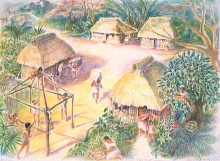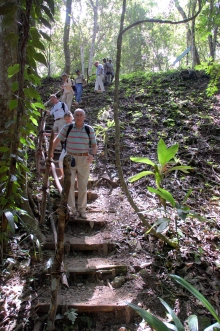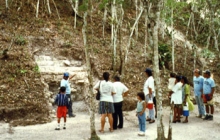El Pilar Archaeological Reserve for Maya Flora and Fauna
"There is no such thing as a patriotic art or a patriotic science. Both art and science belong, like every higher good, to all the world and can be fostered only by the free flow of mutual influence among all contemporaries, with constant regard for all we have and know of the past."
--Goethe, 1749 - 1832
As your plane dips its wings towards the jungle canopies of the Maya forest, there is not much to tell the layman what lies beneath the towering trees. There is little sign of what archaeologists have been surveying for the past years. Neither is there any sign of political borders from the air. But it is under this canopy that the Maya monuments of El Pilar site, stretching over an area of 100 acres.
The monument of El Pilar today show that it was once the primary administration center for the Belize River area, filled with Maya plazas, temples and palaces that were built over a course of 15 centuries, from 500 BC to 1000 AD. How this ancient society developed, and understanding its relationship to the resources and environment of the Maya forest around it is the main objective of the Belize River Archaeological Settlement Survey (BRASS)/El Pilar Program. It is the past that will illuminate the present, and prepare a path for the future.
Ancient Traditions, Contemporary Solutions: The original plan for preserving El Pilar in Belize has grown into an unprecedented multi-nationalprogram that would encompass the remains of the ancient Maya community of El Pilar, complete with plans to develop further research, preserve and cultivate the native resources of the jungle surrounding the center, and improve living standards for villagers in the vicinity. The project has already attracted professionals from a wide variety of fields, from Archaeology to Zoology.
Beyond Borders: The plans for the El Pilar Archaeological Reserve call for the park to stretch into Guatemala's Poniente Pilar, another sector of greater El Pilar connected via an anicent Maya causeway. Just as from the air political boundaries are invisible, we are convinced that the needs and desires of its people bypass politics as well. There has already been a great deal of interest shown from both Belize and Guatemala, and from neighboring Mexico as well.
Building A Future From The Past: If the program's success is dependent on the cooperation among governments, the bottom line of depends on the people of the area. One of the BRASS/El Pilar program's goals is to guide the citizens of the area towards a new way of looking at resource conservation and management. The reserve design will provide short-term benefits for the people, as well as bring responsible long-term solutions to the economic needs of the area.
Through an eco-tourism approach, the reserve will spotlight the daily life of the Maya and their methods of co-existing with the environment. In the main visitors center and throughout the park, research, educational programs and exhibits will show that the people who walk in the Maya's footsteps can benefit from ancient methods to produce a sustainable and economically viable solution to the area's needs.
Making It Work: The BRASS/El Pilar program intends not only to help the local community, but the global community as well. Through the example set by helping citizens keep El Pilar as a monument to the past and convincing evidence for the future, we hope that the project will be used as a model for conservation programs in Central America -- and beyond. We invite you to help us achieve our goals.



